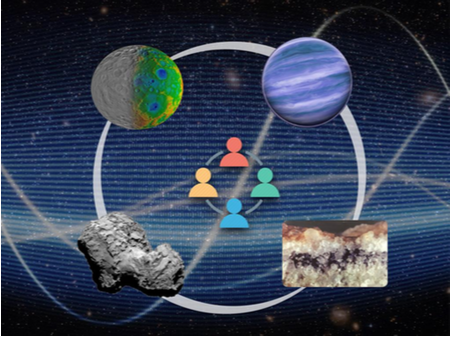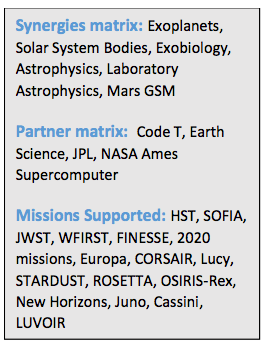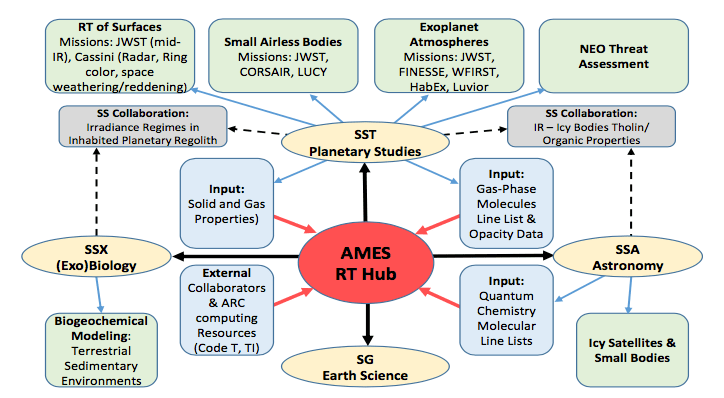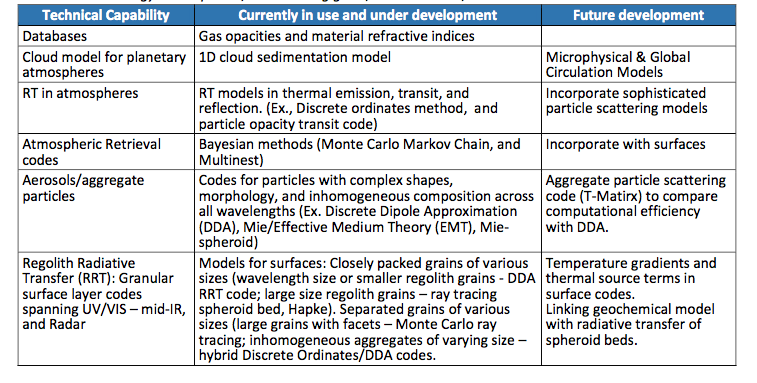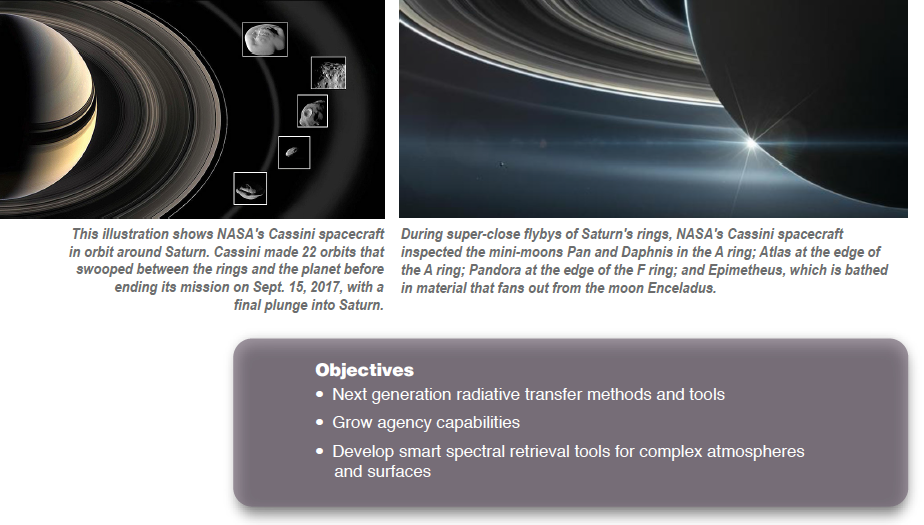Core Capability 4 – Radiative Transfer Research
Radiative Transfer Research Highlights
Upcoming missions such as JWST will reshape our understanding of airless solar system bodies and exoplanets. We propose to integrate the existing Ames radiative transfer teams and resources across research topics and toolsets centered on radiative transfer to form a core leading group in interpreting the vast phase space of the forthcoming observations and providing critical services to the scientific community. This effort will place Division scientists for key roles in future sample return and life finder missions, and in forging international collaborations.
Radiative Transfer (RT) is a fundamental topic needed to interpret all remote observations spanning airless bodies, atmospheres of exoplanets and solar system bodies, protoplanetary disks, and all other astronomical objects. These complex applications require a comprehensive toolset of custom codes and extensive databases of optical properties and atomic and molecular line data. NASA Ames Research Center has a strong and unique core competency in theoretical and computational RT studies, and a long history of applying them to solar system missions. Our expertise goes beyond using currently available models/tools to innovating new cutting-edge methodologies. We have assembled a cross-topic, “capability-focused” team to unify the existing complementary expertise, in order to facilitate progress in all individual topical areas using the same theoretical and experimental tools. The following describes the service and capability-oriented objectives that will apply both to the support and development of NASA missions and to the growth of the scientific community as a whole.
We envision a future institution where we are greater than the sum of our parts. We would like to cross fertilize our personnel and resources at Ames and make/strengthen collaborations across divisions, NASA centers, and academia. Institutions that harness interdisciplinary endeavors will be the trailblazers for future discoveries. As the scientific world becomes ever more complex and the traditional lines between disciplines fade, we need to heed the call of this future just as other institutions are, as evident at GSFC and GISS. This is attainable by facilitating interactions and implementing infrastructure geared toward cross cutting projects.
Objective 4.1 – Next Generation Radiative Transfer Methods and Tools
The Center for radiative transfer research at NASA Ames will be a cross-disciplinary collaboration focused on applied research across the following science areas (Figure 4.1). Detailed models of planetary atmospheres, related to the emission, absorption, and scattering of light by gases and particles should be developed. These models can then be applied to the analysis of Solar System and exoplanet observations and include complex clouds and hazes and surface-atmosphere interactions. Models of regoliths on airless bodies and implications for interpreting past, current and upcoming observations in near and mid-IR are needed as well. Such surfaces can be quite complex in terms of reflectively and emission and also lend themselves to models for inhabited sediment ecosystems. Terrestrial regoliths harboring life interact with the atmosphere via radiative transfer mechanisms. These principles can be tested in the laboratory and prepare us for finding life elsewhere. Finally, determination and curating of optical properties of gas and solids (gas opacities, solid material refractive indices) central to all modeling calculations and derived from both theoretical and laboratory work will be housed in an archive.
We have an extensive model toolset including a world class gas opacity database, collaborators working on theoretical calculations of molecular line lists, and a material properties laboratory group capable of establishing a needed database of optical properties over a range of relevant materials. The gas and particle properties are used in state-of-the-art models of radiative transfer to model atmospheres with clouds and hazes, regoliths of planetary bodies (with or without an atmosphere), and exoplanets. These tools will be used to address the vast phase space explored by upcoming observations.
The developed expertise and tools will be turned into an interconnected hub that employs efficient pipelines, adopts best practices, and provides continuous support for community-wide users. In order to continue and expand our leadership in the development and application of radiative transfer tools we need to not only preserve the existing expertise, but also make investments to employ the newest practices and facilitate communication across teams. Expertise and tools developed in the radiative transfer group will be made available to the Agency and to the community via an archive. The technical capabilities available are outlined in Table 4.1. All these endeavors require an ecosystem of personnel ranging from current staff developing models/theory, to new staff to retain the expertise, and carry on the work of retiring staff, and expertise to adopt best code practices and algorithms on par with current developments.
Objective 4.2 – Grow Agency Capabilities
To ensure continued ARC relevance to upcoming NASA missions, Code S must make strategic investments in capabilities including opacity database development and maintenance, lab and theoretical studies of interactions of radiation with aerosols of various composition, and radiative transfer and atmospheric modeling. Example research tasks would be to interpret transit spectra of super-Earth planets in the presence of various atmospheric absorbers and photochemical and cloud layers, modeling of atmospheric structure of young Neptunes observed by JWST, modeling phase curves of warm Jupiters around M stars measured by TESS, and characterization of habitable planet candidates observed by LUVOIR or HabEx. By supporting the continuing development and integration of our radiative transfer tools and databases, the Ames group could lead the development of new mission concepts to characterize exoplanets and detect potential life markers elsewhere. Development of a cost-effective, but highly community useful public database will allow the all to greatly benefit from the work performed at ARC.
Working with other branches within the division has started, primarily with the exoplanet (SSA) and biome (SSX) groups. Planetary observations from former and upcoming spacecraft will continue to be enhanced through radiative transfer studies, especially those across other Centers. The Ames airborne program and Earth Science research are examples outside the traditional Division science work.
Objective 4.3 – Develop Smart Spectral Retrieval Tools for Complex Atmospheres & Surfaces
In addition to building physically motivated models from first principles, inverse techniques are employed to extract constraints on the model parameters from the data. This inverse problem is referred to as retrieval, following the legacy from Earth and Solar System work. Traditionally this problem was tackled by finding the best fit model in an exceedingly large grid of precomputed models. However, this is very inefficient, the grids can grow fast with more complex models and number of parameters, and the retrieved parameter constraints are limited by the grid spacings. A new generation of Bayesian methods (Monte Carlo Markov Chain, and Multinest) are now being employed to circumvent these issues, and sample the parameter space efficiently, while providing improved parameter constraints and insights into their degeneracies.
While powerful, these methods have their drawbacks, requiring increased computing power and fast, efficient, and accurate radiative transfer algorithms to compute hundreds of thousands of models for each retrieval. We are currently developing such a retrieval package to help guide the design and requirements for the coronagraph instrument onboard future WFIRST mission, and prepare to interpret its observations. The flexibility of these methods makes it appropriate for tackling other observational data, such as those of airless bodies. This is where different groups can bring their expertise together to build new and exciting tools. This would require building a special package incorporating optical data and specific radiative transfer routines for airless bodies, but the existing expertise makes us particularly positioned to tackle it.
We expect to maximize the science return of JWST, WFIRST, FINESSE, and the 2020 exoplanet missions as well as solar system missions Cassini, New horizons, OSIRIS-ReX, Lucy, and CORSAIR. The RT Center at ARC plans to provide modular toolsets (databases & RT models) for general community applications, space missions, and earth and biological science.
Summary
The expected output from this combined effort is to help grow the agency capabilities and enable community science advances. Our capabilities in (objective 1) cloud/aerosol models and retrievals for (exo)planet observations, (objectives 2 & 3) sophisticated models of regolith surfaces applicable to thermal emission spectroscopy of airless bodies and microwave observations of Saturn’s rings, (objectives 4 & 5) opacity modeling, database development and maintenance, laboratory and theoretical studies of optical and physical properties of aerosols and surfaces of various compositions will enable a wide range of community science and support current and future NASA missions. By continuing to develop and integrate our RT tools and databases, we will support the development of new mission concepts to characterize (exo)planets and detect potential life markers elsewhere. A useful, cost-effective public database will allow the community to greatly benefit from our work. We will continue to reach out widely to the community to leverage their expertise, and allow them to leverage ours, to solve problems of diverse types. We would measure success in this area by the number of other groups making use of our models or laboratory-based results, codes, or even facilities. For example, we have already had a mini-workshop for potential users of our Saturn’s rings Monte Carlo code, and several users have contacted us subsequently for follow up regarding Cassini image analysis. Also, the Ames laboratory astrophysics team has a long experience with maintaining a community database on optical properties of PAHs.



























